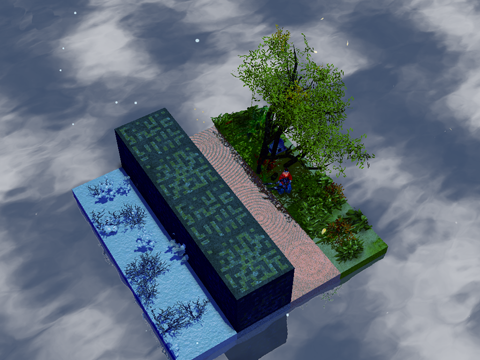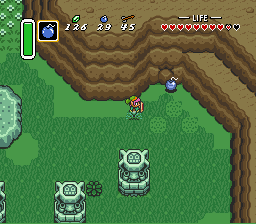
I am fascinated by the parallel between the player’s experience and the scientific process. By playing with a system we get a feel for the rules that govern it. We build up this data on what is possible in this system, and our brains look for patterns in that data to summarize it. By throwing balls, dropping apples, and looking at the moon for a while, humankind was able to formulate the theory of gravity. Formulating a mathematical theory is just another step in a process of finding patterns.
In the above except from the No Ordinary Genius documentary Richard Feynman talks about how research in physics is similar to watching some gods play a chess game without knowing the rules and only being able to see parts of the board. You may learn from careful observation about how the bishop doesn’t change color, or how it may only move along a diagonal. Or you may witness castling and you didn’t expect it.
In old games a lot of gameplay elements where left to be discovered by playing, and not explained verbally using tutorial text. And nowadays there is a resurgence of games that do this, the most extreme example that comes to mind being Starseed Pilgrim which gives almost no hints about many of its mechanics.
Feynman talks about how sometimes in physics there are these unifications and the theories become simpler. They can seem more complicated (possibly because they explain more) but they are actually simpler. Then he says that it doesn’t happen in Chess and that the rules seem to get more complicated. I think this is not true for all rules.
If you only ever saw a queen moving diagonally and suddenly it moved a square horizontally to the left, and maybe later on you saw it moving three squares horizontally to the right, you may think that queens move diagonally, except horizontally three square to the right, and one square to the left, but over time you might realize that they can move any number of squares horizontally and everything becomes simpler again.
However, I assume Feynman is referring to rules like castling or promotion of a pawn to a queen that feel like rules added on top of the previous rules, and can never be unified. Aesthetically these types of rules often feel less beautiful to me. I consider a game that can be “unified” a sign of a beautiful game. It is beautiful from a pure game-design aesthetic sense but in addition the moments when the brain connects these distinct elements into a single whole are magical.

Miegakure brings these concepts from science and games together very tightly because it is as much a game as it is a realization of a mathematical concept. Miegakure is built such that it is simple at first but if you look deeper you can build a better model of what is happening. For example you can play almost the entire game just using the large cubes (actually Tesseracts), but you may gradually learn that your position within each cube does matter. And so your model might expand from thinking you see these thick slices of objects, to knowing you see along an infinitely thin slice and that suddenly explains why things change based on your position (etc…) and your model becomes simpler again.
And there is a beautiful example involving certain blocks being longer along the fourth dimension but because of spoilers I can’t really talk about it in details. But basically, players can build a working ruleset of what is happening, and that allows them to solve puzzles, but that ruleset is very simple. Even people that understand the math well seem to sometimes still use the approximate ruleset because it works so well. I know I do. I love the idea that you could explain the simple rules to someone and they would be able to play, or you could make a game that would be just about these rules, but they are in fact part of a larger, more mysterious whole.

I am reminded of the gameplay layering that happens in good Zelda games: a crack on the wall might not mean much to the player at first, but once the bombs are acquired the whole game world is seen from a new light. In Miegakure the secrets are more intrinsic, and when someone comes to truly understand the unifying rule it is a beautiful thing to see.






People looked at the moon for a verrrrrrry long time before anyone applied the concept of gravity to it. 🙂
I agree with the value of playing around and noticing patterns, but I think there’s something more subtle going on than just “mess around -> notice patterns -> mathematical theory”. Galileo saw patterns that no one else saw because he was messing around in a very systematic way, abstracting patterns into hypotheses and then actively trying to expand the scope of these hypotheses by testing them in different situations.
That is, anyone can notice a pattern, and think of it as specific to that particular context. But it takes a scientific mindset to assume that the world is “beautiful” in your sense (no castling) and attempt to devise an generalization of these patterns that applies to the *entire world*, and is coherent with all other patterns. (This mindset is a relatively recent invention, maybe 500 years old.)
I think the reason that games like Miegakure encourage a sort of scientific thinking is that they are “microworlds” (in the Papert sense) — the entire premise of the game is that the entire world operates under a simple, coherent set of rules, and the player goes in knowing this. So players will be alert to patterns, and try to generalize them by generating and testing hypotheses, because they are in a context where they know that they are supposed to do that. (That same person probably would not apply scientific thinking in many other areas of their life.)
And there are ways in which the gameplay is not scientific (e.g., the player never has to devise an explicit representation of the pattern which can be communicated to someone else).
You probably would really like Andrea diSessa’s chapter on “Knowledge in Pieces”, which is all about this sort of thing: http://worrydream.com/refs/diSessa%20-%20Knowledge%20in%20Pieces.pdf
(Actually, I really just wrote this comment in order to send you that link.)
(Sorry for the super-late reply, holidays happened)
Yeah, I do not think that it is simple. I am just saying that it is interesting that brains are natural pattern finders and that mathematical theories are a different way to apply that pattern finding, but still they are just pattern finding.
The thing about trying to expand the scope of hypotheses is very powerful but also the moment you realize that your brain built a pattern subconsciously and you turn it into a conscious theory is important as well.
That link is great, thanks!
Bret made a good point: we imagine the playing game from ads and friends’ reviews (e.g. http://kotaku.com/5478437/are-you-playing-a-video-game-before-you-are-playing-it).
Because 4D is the hook, I come to Marc’s game expecting to explore a beautifully coherent rules that define a ‘correct’ or ‘true’ 4D spatial system. I expect him to simplify any tedious parts of 4D spatial math until I can enjoy it, in a semi-flow state, but I’ll be frustrated if I discover his simplifications are cheats on ‘true’ 4D spatial math (e.g. portals, or puzzles that aren’t really 4D but just seem like it). It’s OK if he clearly labels these as cheats, but I am trusting him to show me a simplified view of reality.
In other words, it’s important to me as a player that my skillset I gain from playing isn’t fake. When I handle real-world 4D problems – e.g. quaternions, space-time, – I don’t want to be embarrassed by citing a fake ruleset in those contexts. e.g. I don’t want to be the Gilligan’s Island fan kid might embarrass himself by suggesting one can build a radio from coconuts.
I want Marc’s game because it is a learning game, on a topic I’m interested in. Good learning games entice the player to climb the skill-building ladder to master a complex system behind the mechanic(s), while keeping the experience playful and engaging. Fortunately, the hook of 4D contains humility. I come to Marc’s game with the assumption that my brain is ill-equipped to understand his system. I expect to try to apply my 3D skillset to 4D, fail, and to be hand-held through creating a new 4D spatial skillset.
My fingers are crossed that Marc pulls this off – I LOVE his vision of playing in 4D.
That is why I like to press buttons randomly sometimes just to find out what is an acceptable rule. Dangerous but rewarding. 🙂
So glad I’m not the only one who doesn’t like to use castling and en passant because they’re less beautiful than just playing the game. I barely even like to kill things with the pawns.
What? They can only move diagonally to take stuff? Hmmm…
Needless to say, I don’t win that often 😛
I have a feeling that the unifying moment of this game will be well worth the wait!
Hah, how apropos that you would use Zelda: ALTTP as an example. That game’s “parallel worlds” can be thought of as two 3D hyperplanes in 4D space, with the mirror/portals linking them (horrible pun intended).
Not a coincidence! 🙂